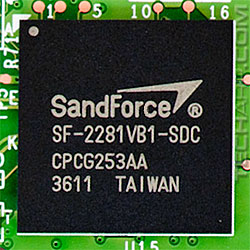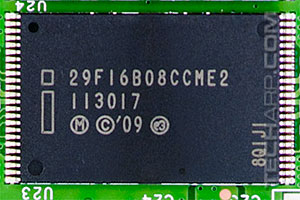The SSD Controller
 Intel went off the reservation when they came up with the 520 Series solid-state drives. Codenamed Cherryville, it represented Intel's first collaboration with SandForce. Like many performance-grade SSDs for the enthusiast market, the Intel 520 Series SSDs are based on the SandForce SF-2281 controller. However, they use Intel's customized firmware which took over a year to develop and validate.
Intel went off the reservation when they came up with the 520 Series solid-state drives. Codenamed Cherryville, it represented Intel's first collaboration with SandForce. Like many performance-grade SSDs for the enthusiast market, the Intel 520 Series SSDs are based on the SandForce SF-2281 controller. However, they use Intel's customized firmware which took over a year to develop and validate.
Although other manufacturers can use the same Intel NAND flash with the same SandForce SF-2281 controller, it is this extended validation that differentiates the Intel 520 Series solid state drive from other SF-2281-based SSDs - greater reliability with fewer bugs. This firmware is apparently exclusive to Intel for a period of time, so while bug fixes and improvements from Intel's validation efforts will eventually filter down to other SF-2281 drives, it won't be anytime soon.
The SandForce SF-2281 has the following specifications :
NAND Interface |
• 8 Channels, 8-Byte Lanes |
NAND Flash Memory Support |
• MLC from numerous top flash memory manufacturers |
Maximum Capacity Supported |
• 512 GB (using 32 Gb or 64 Gb/die components) |
Key Features |
• DuraWrite™ Technology |
Data Security |
• Data Encryption: AES-256 & 128 |
Reliability |
• ECC Recovery: Up to 55 bits correctable per 512-byte sector (BCH) |
Host Interface |
• SATA 6Gb/s, 3Gb/s and 1.5Gb/s support |
Package |
• 256-pin TFBGA |
Industry Compliance |
• RoHS, Halogen-Free, Green |
The NAND Flash Memory
 The 240 GB Intel 520 Series solid state drive uses the Intel 29F16B08CCME2, which is a second-generation 25 nm MLC (Multi-Level Cell) chip with a 16 GB storage capacity and an 8-bit data path. It is a synchronous part which is not only faster than asynchronous NAND flash parts but also runs at just 1.8 V, instead of 3.3 V.
The 240 GB Intel 520 Series solid state drive uses the Intel 29F16B08CCME2, which is a second-generation 25 nm MLC (Multi-Level Cell) chip with a 16 GB storage capacity and an 8-bit data path. It is a synchronous part which is not only faster than asynchronous NAND flash parts but also runs at just 1.8 V, instead of 3.3 V.
There are 16 of these MLC NAND chips - 8 on both sides of the PCB, with a total storage capacity of 256 GB. As this Intel 520 Series SSD has an official storage capacity of 240 GB, that means Intel only over-provisioned by a paltry 6.7%, or one extra NAND flash chip for every 15.
Over-provisioning of NAND flash memory is important as it increases write IOPS performance by providing pre-erased blocks ready for use in the virtual pool of flash memory. It also increases the perceived lifespan of the solid state drive by swapping bad blocks that develop over time with spare blocks. This over-provisioning can be as much as 20% as MLC flash memory don't have a very long lifespan.
In fact, the lifespan of MLC flash memory gets worse as the lithographic process gets smaller. For example, each cell in this Intel NAND flash memory chip is rated for only 5,000 program / erase cycles. That said, Intel claim to reserve the crème de la crème from every batch for their solid-state drives, so it's possible that these specially-selected chips will last far more than the 5,000 P/E cycles they are rated for.
SSD Maintenance
First of all, you should never, ever defragment solid state drives using the usual hard disk drive defragmentation software. Spatial fragmentation of data has no effect on SSD performance - fragmented bits of data are accessed just as quickly as nicely packed blocks, so it is pointless to "defragment" the data blocks in the traditional sense. Doing so will also reduce the flash memory cells' lifespan by putting them under additional wear. This is important as MLC flash memory will only last about 5,000-10,000 program/erase cycles, and it will only get worse as the lithography process gets smaller.
Unlike hard disk drives, flash-based SSDs write and overwrite data in large blocks of 512 KB to 1 MB in size. Even if you only need to overwrite one byte of data, it has to erase and overwrite an entire block. This causes a lot of wear on the memory cells and greatly reduces their lifespan. To prevent that from happening, SSDs perform wear leveling by spreading the writes so that the flash memory cells have equal wear.
To further improve lifespan and performance, some SSDs use an SDRAM write buffer to temporarily store and combine writes before they are actually written to the flash memory. This reduces the number of block erases required and increases the memory cells' lifespan. SandForce controllers do not use such a write buffer to reduce cost and complexity. Instead, they use on-the-fly data compression to reduce the amount of data to be written to the flash memory.
As helpful as wear leveling and the write combine buffer (or on-the-fly data compression) are, they cannot address the issue of "dirty" blocks, which will develop over time. Most operating systems will not directly inform the SSD which data blocks have been deleted. They will merely flag the deleted data blocks in their file system so they can be overwritten by new data.
Unlike the magnetic media in hard disk drives though, the NAND flash memory cells in solid state drives can only be written to if they are empty. Cells that contain data (even useless, deleted data) must be erased before any new data can be written to it. This requires the SSD to perform the time-consuming read-erase-modify-write cycle to overwrite the "dirty" block, which not only cripples performance but also increases wear on the affected memory cells.
To counter this, newer SSDs support the TRIM command, otherwise known as the ATA8-ACS-2 DATA SET MANAGEMENT command. Operating systems that support TRIM (e.g. Microsoft Windows 7) will notify the solid state drive when data blocks are deleted in the file system. This allows the solid state drive to perform garbage collection in the background - internally erase the affected blocks so that they are ready to be written to.
Like many modern SSDs, the Intel 520 Series solid state drive supports TRIM. It also has an internal internal garbage collection feature which cleans up "dirty" blocks on a periodical basis, if it is ever used with an operating system that does not support TRIM.
Support Tech ARP!
If you like our work, you can help support out work by visiting our sponsors, participate in the Tech ARP Forums, or even donate to our fund. Any help you can render is greatly appreciated!
Page |
Topic |
|
1 |
|
|
2 |
||
3 |
• The 240 GB Intel 520 Series SSD |
|
4 |
• The SSD Controller, The Flash Memory |
|
5 |
• Testing The 240 GB Intel 520 SSD |
|
6 |
||
7 |
||
8 |
||
9 |
||
10 |
||
11 |
||
12 |
||
13 |
||
<<< The 240 GB Intel 520 Series SSD, Usable Capacity, Specifications : Previous Page | Next Page : Testing The 240 GB Intel 520 SSD, Max. Surface Temperature, Transfer Rate Profile >>>







 Add to Reddit
Add to Reddit
